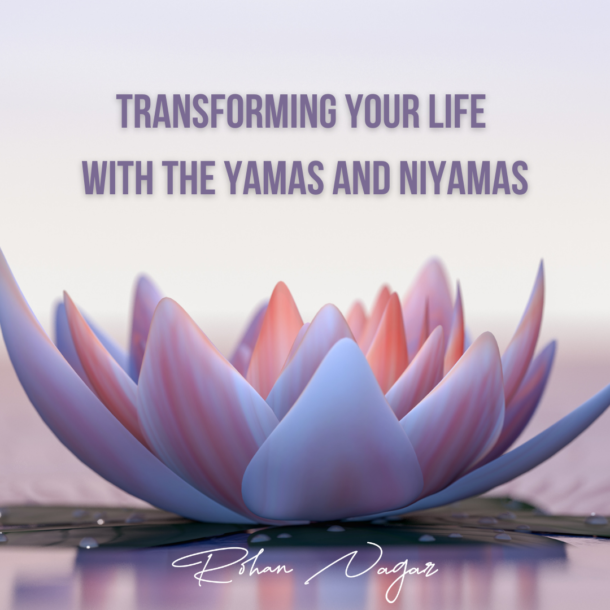
Exploring the connection between Ayurveda and Yoga
Before we talk about yoga, let’s take a quick look at the importance of exercise, and how exercise relates to Ayurveda.
To achieve optimal health, we must eat a proper diet, take proper exercise, and enjoy proper rest.
Exercise is essential because it boosts our energy, supports our immune system, and protects us from a wide variety of health problems and diseases. It keeps our joints lubricated and helps control our weight. It supports detoxification by igniting a metabolic fire (‘agni’) inside us, which keeps the channels of our body flowing smoothly. In turn, this strengthens our circulation and digestion, maintains fluidity in our tissues, and improves elimination of waste and toxins. Exercise builds and maintains muscle, lifts our mood, and enhances concentration, alertness of mind and clarity of thinking. It also releases tension, increases confidence, improves our ability to relax, and promotes better sleep.
And that’s only the beginning of what regular exercise can do for you. There are many other benefits as well.
Unfortunately, thanks to the pressures of modern living, most of us don’t move and exercise as much as we should. That’s one of the biggest reasons why the world’s population is getting steadily sicker, and viruses like COVID-19 are having such a devastating impact.
The Ayurvedic approach to exercise
The western world has a very ‘all or nothing’ approach to exercise. We’re programmed to believe we’ve got to “feel the burn” and if there’s “no pain” there’s “no gain.” The general feeling is if we don’t push our bodies to the limit, what’s the point in exercising at all? That’s why so many people either avoid exercise entirely or start exercising obsessively and then give up after a few days or weeks because they literally can’t stand the pace.
The Ayurvedic approach to exercise is very different. In Ayurveda, exercise is all about consistency and moderation and choosing the kind of exercise activity that will motivate you and suit your body best. Exercise shouldn’t be a chore. It should be strengthening, grounding, vitalising, and energising. It should challenge us, but not to the extent that we don’t enjoy doing it, or we risk damaging ourselves. Just like every other aspect of Ayurveda, exercise should be about you, your journey, and nourishing your body, mind, and spirit. We are all unique, and a fitness activity that benefits one person might not benefit another. It may even do more harm than good.
The importance of balance
In Ayurveda, maintaining the balance between body, mind, and consciousness is vitally important to achieving good health. Like increases like, and countless factors could upset our balance at any time, including physical and emotional stresses, problems at work and in relationships, or changes in the seasons and the weather. Ideally, we need to stay mindful of how all these factors interact within our bodies and our lives, so we can keep our doshas in balance and maintain the natural order. Even though getting your body moving is critical, the best exercise for you is the one that pacifies your predominating dosha.
In a future blog, we’ll look at each dosha individually, and talk about the kind of exercise that suits each dosha best. For now, I’ll just mention two guiding Ayurvedic principles that it’s useful to follow, no matter what kind of exercise you choose.
1. The 50% rule
In general, Ayurveda recommends exercising to 50% of your capacity. A good indicator that you’ve reached that point is when a mild sweat breaks on your forehead, nose, or underarms, and when breathing through your nostrils becomes more difficult. (Note: a good way to ensure you’re putting in the right amount of effort is by breathing through your nose during your workout.) It will feel challenging at first, but, with more practice, you’ll quickly start to build up a tolerance and be able to work out harder and longer.
2. Try to exercise during Kapha time
No matter what dosha type you are, Ayurveda recommends exercising during the Kapha time of day (between 6-10 am and 6-10 pm.) These are the periods when Kapha is dominant and, because Kapha has the heavy, grounded energy of water and earth, it counteracts the feelings of lightness and mobility that exercise gives us. Exercising during these times of day can stop us feeling sluggish, clear mental fog, and heighten our sense of well-being.
If you can’t exercise during Kapha time, find a time of day when undertaking exercise will be most convenient and comfortable. The easier you make exercising, the likelier you are to continue. Also remember that exercising during Pitta times (10 am – 2 pm, 10 pm – 2 am) and Vata times (2-6am and 2-6 pm) can easily aggravate those doshas, so be mindful of any discomfort you may be feeling.
What makes yoga such a perfect form of exercise?
Ayurveda and Yoga are sister sciences. Ayurveda is the science of life and longevity (in Sanskrit, ‘ayu’ means ‘lifespan’) and, in Sanskrit, Yoga literally translates as “union”, “joining or yoking together.” In other words, Ayurveda and Yoga are both focused on achieving better health through the unity of mind, body, and consciousness. They share the same origins and goals. Where Ayurveda was developed for healing and the prevention of sickness, yoga is a spiritual practice aimed at relieving inner suffering. Traditional yoga schools have always taught ayurvedic principles as well as yoga asanas (body postures), because the two sciences are so deeply interrelated, and they’re linked by the vital life force energy called ‘prana’. Together, they form a unified, holistic system of self-improvement, self-control and self-restoration. For example, while regular yoga practice helps to cleanse ama (toxins) from the body, Ayurvedic practice ensures the body is purified, so amais less likely to return.
As a form of exercise, yoga is perfect for Ayurveda because it rejuvenates the body, removes stress, encourages blood flow, and improves digestion. It balances all three doshas, assists the cleansing of internal organs, and strengthens every part of the body. During a single yoga routine, different poses will affect the doshas in different ways. That’s why some people create a customised yoga sequence, based on Ayurveda, that will keep their body and mind healthy and balanced.
Which type of yoga should you choose?
It depends upon the nature of your constitution (‘prakruti’)and the nature of your imbalance (‘vikruti’).
Your prakruti is determined by how your three doshas were balanced at the moment of your original creation, when your physical and psychological tendencies became fixed. Everything about you, including your body type, your personality, the texture of your skin, the efficiency of your digestion, is wrapped up in your prakruti.
Your prakruti is unique and won’t usually change during your lifetime.
Your vikruti is the state your three doshas were in after the moment of your original creation, and how they’re currently expressing themselves in your body and mind. While knowing your prakruti is essential for understanding who you are and how you function, knowing your vikruti is crucial in understanding what imbalances you, so you can treat it in the correct way.
For example, Vata people will gain most from a yoga practice that is relaxing, soothing and warming. Pitta people will gain most from a yoga practice that is relaxing, soothing and cooling. And Kapha people will gain most from a yoga practice that is stimulating and warming. If you don’t practice the yoga that supports your dosha, you’re likely to experience even more imbalance.
Ayurveda, Yoga, and the importance of breathing
- The yamas
- The niyamas (I covered both the yamas and niyamas in my previous blog
- asanas (postures)
- pranayama (breath control)
- pratyahara (withdrawal of the senses)
- dharana (concentration/focus)
- dhyana (meditation)
- samadhi (bliss/being ‘at one’)
Pranayama is important to all of these because breathing is vital to everything we are. All our thoughts and feelings are affected by our breathing, and practising pranayama gives us control over our breathing rhythm.It also soothes and massages our internal organs. For this reason, pranayama and ‘breath awareness’ are essential in all forms of yoga practice, and every yoga session should be taken as an opportunity to concentrate upon the breath. As the Yoga Sutras of Patanjali tell us, “When the breath is steady, so is the mind.”
Aside from its importance in yoga, pranayama is especially beneficial in the treatment of depression, anxiety, panic disorders, and mental illness. It’s a cleansing inhaling and exhaling technique that stimulates well-being, and calms and focuses both the body and the mind.
I’ll talk about pranayama again in my next blog and describe some useful pranayama techniques you can use.
The main types of yoga
Although there are many different types of yoga; Ashtanga yoga, Hatha yoga, Iyengar yoga and Vinyasa yoga are probably the most popular.
Ashtanga is translated as ‘eight limb path’. It’s a highly structured type of yoga that’s composed of salutations, standing poses, inverted poses, and seating poses. The practice is identical from day to day, and each pose must be performed quickly and powerfully, with a strong sense of purpose. It’s a demanding yoga form that works every part of your body.
Hatha yoga is popular with beginners because it is usually performed more gently than other yoga styles, with a more classic approach to breathing and exercises. In Sanskrit, Hatha means ‘force’ and is the foundation of all yoga schools. A typical hatha yoga class will include postures and breathing techniques and might also involve chanting or reciting mantra and types of visualisation.
Iyengar yoga comes from the most classical Hatha yoga tradition. It has an emphasis on body alignment (paying attention to the alignment of poses improves mindfulness), sequencing (the order the poses are practised) and timing (poses are held for more extended periods, to develop strength and flexibility, and nurture the connection between body and mind). It’s perfect for people who need to work slowly and methodically, or are recovering from injury.
Vinyasa yoga is often described as the most athletic yoga style, characterised by linking postures together, so you move seamlessly from one pose to another in coordination with the breath. For that reason, it is also known as ‘flow yoga.’ There can be many types of poses in different sequences, and no two classes will ever be the same. Because of this variability, vinyasa yoga is especially good for developing a balanced body while avoiding repetitive motion injuries.
Final thoughts
I highly recommend including yoga as part of your Ayurvedic lifestyle. Practised together on a daily basis, they offer a total system of well-being for the mind, body, and consciousness which – in my opinion – is unmatched by anything else offered by the rest of the world. It is holistic and spiritual and genuinely transformative. I’m sure we’ll be returning to this subject in later blogs but, in the meantime, if you have any questions or would like my help to identify your dosha and discover the best yoga practice for you, please do not hesitate to get in touch.
Until next time, to your enduring health and happiness in Ayurveda.







